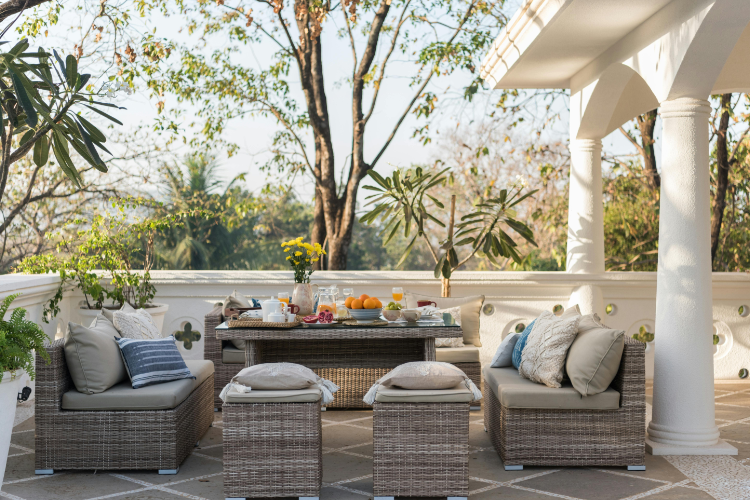
How to Maintain Wicker Furniture in Florida’s Humid Climate
Posted by Zing Patio on May 5th 2025
Wicker furniture is a timeless favorite for Florida patios, sunrooms, and lanais thanks to its breezy charm and versatility.
However, Florida’s humid climate—with its mix of heat, rain, and salty coastal air—can pose challenges to wicker’s longevity, especially if you’re not using weather-resistant materials. Fortunately, with proper care and maintenance, you can keep your wicker furniture looking beautiful year-round.
At Zing Patio, with locations in Naples, Fort Myers, and Sarasota, we specialize in helping Florida homeowners protect and preserve their outdoor investments.
Here’s how to maintain your wicker furniture so it stays strong, stylish, and weather-ready.
1. Know Your Wicker: Natural vs. Synthetic
Understanding the type of wicker you own is the first step to choosing the right maintenance routine.
Natural Wicker (Rattan, Bamboo, Reed):
- Made from organic plant materials.
- Best suited for indoor or covered outdoor spaces, like sunrooms and screened patios.
- Highly susceptible to moisture damage, mold, and UV fading if exposed to the elements.
Synthetic Wicker (Resin or HDPE Wicker):
- Made from high-density polyethylene (HDPE) or other plastics.
- Engineered for outdoor durability, including resistance to moisture, mildew, and UV rays.
- Commonly used in modern patio furniture for Florida’s climate.
Tip: If your furniture is placed in an open-air setting like a pool deck or garden, synthetic wicker is the smart, low-maintenance choice.
2. Regular Cleaning is Key
Humidity can cause dirt and pollen to cling to your furniture, making it a breeding ground for mold and mildew. Routine cleaning will keep wicker looking fresh and extend its lifespan.
Cleaning Steps:
- Dust weekly using a soft brush or vacuum with a brush attachment.
- Wipe down with a mild soap and water solution (avoid harsh chemicals).
- Use a toothbrush or soft-bristle brush to clean between weaves.
- Rinse with a garden hose (for synthetic wicker only) and allow to air dry completely.
Pro Tip: For natural wicker, avoid soaking. Instead, use a damp cloth and dry immediately to prevent swelling or warping.
3. Protect Against Mold and Mildew
Florida’s humidity can lead to mold and mildew, especially during the rainy season or when furniture is placed near plants or shaded areas.
Prevention Tips:
- Place furniture in well-ventilated areas to allow airflow between and beneath pieces.
- Avoid direct ground contact by using risers or placing furniture on outdoor rugs.
- Apply a mildew-resistant spray (available at outdoor furniture stores) to natural wicker annually.
- Clean spills or wet cushions quickly to prevent moisture buildup in wicker fibers.
If mildew forms, gently clean it with a mixture of white vinegar and water, then rinse and dry thoroughly.
4. Provide Shade and Cover When Needed
Even synthetic wicker can degrade over time if constantly exposed to harsh Florida sun or torrential rain.
Smart Protective Measures:
- Use UV-resistant furniture covers when not in use.
- Position furniture under a covered patio, pergola, or awning to shield it from sun and rain.
- Bring cushions and decorative pillows indoors during storms or periods of heavy humidity.
- For natural wicker, consider moving furniture indoors or into a screened enclosure during summer months.
Tip: Invest in breathable covers to prevent mold caused by trapped moisture.
5. Touch-Up and Reseal Natural Wicker

If you’re using natural wicker furniture in a protected outdoor space, regular maintenance like resealing can dramatically improve its resilience.
Steps to Protect Natural Wicker:
- Reapply a clear outdoor varnish or polyurethane once a year.
- If the color is fading, use a spray paint formulated for wicker to restore vibrancy and add protection.
- Inspect for loose weaves or cracks, and repair them early to prevent bigger issues.
6. Don’t Forget the Frames
Wicker furniture often comes with aluminum or steel frames underneath the woven material.
Frame Maintenance Tips:
- For aluminum frames, clean with mild soap and water and check for signs of corrosion.
- For steel frames, inspect for rust and touch up with rust-resistant paint as needed.
- Make sure any screws, joints, or brackets are tightened and free of rust to ensure the furniture remains sturdy and safe.
7. Rotate Furniture for Even Wear
In high-humidity environments like Florida, rotating your furniture occasionally helps prevent uneven fading, moisture buildup, or warping on one side.
- Rotate chairs and tables every few weeks to expose all sides equally to sun and wind.
- Flip cushions regularly to prevent mildew from forming on the underside.
8. Seasonal Storage Strategies
While Florida allows for outdoor living all year, extreme weather during hurricane season calls for added precaution.
Storage Tips:
- Store wicker furniture in a garage, storage shed, or indoors during severe weather events.
- Use stackable designs or foldable chairs for easier off-season storage.
- If year-round storage isn’t feasible, tie down lightweight wicker pieces to prevent wind damage.
Zing Patio: Wicker Furniture Built for Florida Living
At Zing Patio in Naples, Fort Myers, and Sarasota, we carry a wide selection of synthetic wicker patio furniture built to thrive in Florida’s humid conditions.
Whether you’re shopping for a coastal-inspired sectional, classic woven dining set, or a modern wicker lounge, our expert team will help you choose the best options for comfort, style, and durability.
We also offer weather-resistant cushions, protective covers, and care products specifically tailored for Florida’s unique climate—ensuring your wicker furniture stays beautiful for seasons to come.
 Top Brands, Extensive Selection
Top Brands, Extensive Selection  Guaranteed Lowest Prices
Guaranteed Lowest Prices 
